I’d like to thank Butch Wise and Jimmy Ellers for their input in this article.
First Year Sires
Standing a first year sire can be full of rewards, but you must be ready to make a long-term commitment to that stallion.
Creating Raving Fans for Quarter Horse Racing
I’d like to thank Butch Wise and Jimmy Ellers for their input in this article.
Standing a first year sire can be full of rewards, but you must be ready to make a long-term commitment to that stallion.
The crowds of people headed for the track. The smells of race day. The excited anticipation. We were at the races; unfortunately it was cars going around the track instead of horses.
Last spring we had some friends who weren’t going to use all of their seats at the Nascar races in Kansas City so they invited us to go along. This was not something neither my husband nor I had ever been interested in doing but we’re always open to new experiences, right. So we drove across the state for a weekend full of racing.
This is the same trek we had made more than once when I had horses on the track since the Kansas Speedway is just down the road from The Woodlands. But I had no idea of what we were going to experience. I remember when Diane Ciarloni wrote in Speedhorse about the opening of Texas Speedway and the throngs of people going to the races. Why doesn’t horse racing draw those types of crowds?
I asked our friends what they liked about Nascar. Roger said he enjoyed the adrenaline rush and Missy said she loved the social aspect. Both reasons that I understand after all I’ve been going to the horse races and riding barrel/pole horses and hunter/jumpers since I was a small girl to get my adrenaline rush and who doesn’t love to spend time and talk with like-minded people.
Their seats were in row 14 just before the finish line so we had a great vantage point. As a photographer I was very disappointed to see that there was a fence between me and the cars but I suppose when something is moving that fast should it lose any parts it would be dangerous if the fence weren’t there.
The call to the post, the post parade, the smell of horse sweat and manure and the excitement of the announcer calling the race are all things that I love. Here they announced each driver and they were driven by in a pickup and the fans went wild.
At the start of the race they all lined up and went several laps around the track before the race actually started I guess they had to all be in the right post positions before they could start. And they were off. The rubber burned and the air was laden with the smell of fuel.
Ok, so then the rush of adrenaline burst through me. But after a few laps it was just a bunch of cars going around the track. Then there was a problem with one of the cars and everyone slowed down and got in line until the track was cleared and the race was on again. This happened a few times but there were no major accidents on this day, which Roger was apologetic about.
Throughout the day there was a man a few rows down that would wave a t-shirt that he was holding every time the cars would go by, I never did figure out for which driver he was cheering. And on this particular day it was obvious which car would win several laps before the end of the race. No come from behind victory. Very anti-climactic.
I would think the fans would love Quarter Horse Racing as well. After all it’s pure adrenaline for 17 – 21 seconds, you can get the rush 10 – 12 times during the day and you have the added rush of gambling on the outcome of each race. As an added bonus you can visit with your friends about your betting choices between races.
One thing that I noticed was all the corporate sponsorships. Each car and driver was covered with logos and the colors of their sponsors. They also had huge trailers outside the grandstands where you could buy merchandise with your favorite driver’s name, number and some of the corporate logos printed on them.
Nascar also does a tremendous job of making the drivers celebrities. What would happen if we made our horses, jockeys, trainers and owners into celebrities? Look what happened with Zenyatta. People who had no connections with horse racing fell in love with her. Mike Smith and Chantel Sutherland have more visibility with the general public than most jockeys even if you don’t agree with how they won that awareness.
Roger and Missy had a headset that they could tune into a driver’s frequency and listen to the chatter between the driver and the pit crew. I can see how this would make the whole experience much more entertaining. Is there some way we can incorporate something like that?
Quarter Horse racing needs to start telling its stories to the public. With the Internet and social media we can reach more people than ever before. Kick the gates and let the story telling begin!
That’s my quarter’s worth. Let me hear yours by leaving a comment below.
It’s the time of year when Quarter Horse Racing owners are over flowing with the excitement of new foals arriving and decisions about breeding our mares are being made.
My husband and I had moved to my grandparent’s farm to help with the farming and the horses the first of April. I was pregnant with our first child who was due in August. In late May grandpa died and we were left to make decisions about the farm and horses with a family who either weren’t involved in the industry or were scattered somewhere between Kansas and California.
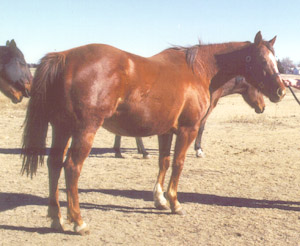
Hopeful Bug – Bugs Alive In 75 out of Desolate Angel by Hopeful Venture TB several years after the C-section.
It was a bright day in January and I was headed into town. Mike says he thinks Hopeful Bug, a maiden mare, might be ready to foal, she’s acting funny; he’ll keep an eye on her. Mike has calved out many calves in his lifetime but neither one of us has had a solo experience with foaling nor had we had much experience at all.
When Charlie, 5 months old, and I return he’s still watching Bugs and thinks there might be something wrong because it’s been so long and she’s not progressing. I take stuff in the house and put Charlie down for a nap. When Mike returns the foal is coming but there are no feet presenting just the nose.
My uncle is a race track vet in California so he tries to call him but there is no answer. So we call our local vet. Dr Hawkins shows up as soon as he can and starts to try to grab the legs so he can deliver the foal normally.
The baby monitor does not work well in the barn so I can only go out for brief periods of time. It seems like every time the vet gets a good hold on the foal the mare either slams her body to the ground or gets up just as fast as she fell down the previous time.
Larry, the vet, says that he can get a good hold on the back legs but is having trouble getting the front legs. This is not a good situation and he’s exhausted would I call the clinic and get one of the other vets to come help?
After Dr Winters gets there and examines the mare they discuss it and say that we have a couple of options: do a C-section or put the mare down. We still haven’t been able to contact my uncle so we have to make this decision on our shoulders. The best option seems to do a C-section, that’s what Mike would do with a cow.
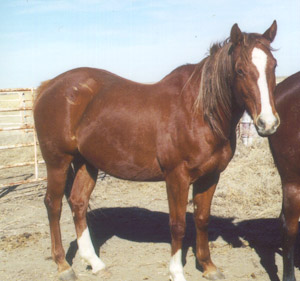
So Secretive – Raise A Secret out of Hopeful Bug by Bugs Alive In 75. One of several foals out of Hopeful Bugs and one of two by Raise A Secret.
So the vets get some straw bales to prop the mare up on her back and took the foal out right there in the barn. The surgery went smoothly. Bugs was getting up while they were putting in the last stitch. No surprise the baby was already dead and he was also huge.
No matter what anyone else says, and when my uncle did finally call back he said there were “other options”, we have always felt that we did the right thing by Hopeful Bug. The next summer when we purchased some of the horses from the estate, even though we were not sure we’d ever be able to breed her, we bought Hopeful Bug. After all grandpa had thought enough of her to buy her as a yearling to breed to Raise A Secret and that was what I wanted to do.
That’s my quarter’s worth. Let me hear yours by leaving a comment below.
I’ll admit I have mixed feelings about horse racing medications. I understand the need for therapeutic medication. Who hasn’t taken ibuprofen, naproxen sodium or aspirin on occasion? I was on Naprosyn for a year for a shoulder injury. I live with an asthmatic so I definitely understand the benefits of clenbuterol having lived with rescue inhalers for 26+ years. And Lasix has been proven beneficial in horses that bleed. But where do you draw the line? How do you know if a horse needs medication?
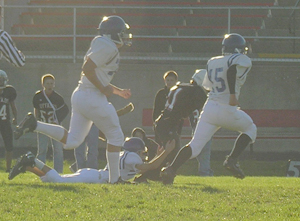
My son tackles an opposing player. He’s the one on the ground holding onto the black player. If you look closely you can see the ankle brace on his right ankle.
I’ve had a few heart-wrenching, eye opening experiences watching my children in middle school and high school sports activities. My eighth grade son hurt his ankle in football practice and was taken to the hospital for x-rays. The doctor, my dad, and nurse practitioner who looked at the x-rays didn’t see anything of major concern.
The radiologist who read the x-rays the next day did and since there was a visiting orthopedist in town we went to see him. He proclaimed that he had a fracture in his growth plate but it was not too worrisome. Although the thought of a fracture in the growth plate of a 13 year old boy sounded serious to this mother. He was put on Tylenol and ibuprofen, which he refused to take, and put in a boot for two weeks.
When the two weeks were up, and he had been walking on it, the orthopedist said we must have “over read” the x-ray. So he resumed light activity and injured it again in PE. The doctor who read this x-ray said it looked like he had an old fracture that hadn’t healed so we were back to the orthopedist who told him to stay off of it for another two weeks.
When he was finally allowed to play I remember watching him limp onto the field after being taken out for a play and thinking if he were a horse I wouldn’t ride him. But when I asked him about it he responded “but mom it doesn’t hurt.” Then why was he limping?
He’d reluctantly spent basketball season in an ankle brace and now wanted to stay in shape to run the two mile in track. Because we had so much snow that winter we got a tread mill. He wasn’t running so I asked him why. He responded his foot hurt when he ran. After about a month of this and consulting with my dad who now winters in Texas I took him to see another doctor.
Another x-ray. She said there was a small break, the radiologist said there wasn’t. He was put in another boot for 6 – 8 weeks. This one came off a week before his first track meet where he ran the in the 4×200 relay, the 1600 and triple jumped. He also asked the coach to scratch him from the 800 because he didn’t feel up to running anything else. But it amazes me that a 13 year old was able to do so much in such a short time.
My hunter/jumper, Zandy Parr, had tender feet. He could be perfectly sound but if he stepped on a rock during his soundness circle I could be disqualified because he looked lame for a few steps. It didn’t take long to have the farrier put pads on him before I took him to a show where we knew there were a lot of rocks.
We finally gave up on another hunter/jumper. He had beautiful, possibly World Championship, form and would go great for a while then would just stop at the fences. We’d lay him off for a while and he’d be great again, for a short time. He was also one that would have a minor injury and be three-legged lame; he might not even come in to eat. We never did figure out if he had physical or mental issues or both. He was sold to be a trail riding horse.
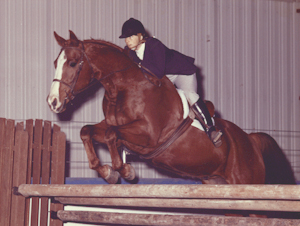
Westbound Viejo, Dummy, jumping in Columbia, MO. Hmm, maybe the nick name is why he had those problems. Photo by Dan McClatchey Photography.
My point is how do we really know when a horse is hurting so much that it shouldn’t compete? My son, who was obviously lame, said it didn’t hurt and went back on the field in one instance and asked to be scratched in another. The x-rays were apparently inconclusive since they were read differently by so many doctors. But he could at least tell us how he was feeling.
The horse can only tell us it hurts with its actions. Is it limping? Is it cranky or sensitive to touch? Medication can certainly help race horses recover from injury or help with a breathing or bleeding problem. But do we put them “back in the game” too quickly?
Olympic athletes who can tell us what they feel can be disqualified for a bad test and professional athletes probably push their bodies too far. How do we know we are not pushing our horses too far?
There is no way to be 100% sure. We can only have the vet run tests, observe their behavior and movement and use our best intuition. We do our best to make sure that they don’t break down on the track unfortunately sometimes our best isn’t good enough.
That’s my quarter’s worth. Let me hear yours by leaving a comment below.
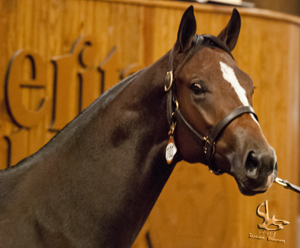
Ms First Prize Rose, 2011 bay filly by Coronas Cartel out of First Carolina by Mr Jess Perry, in the sale ring.
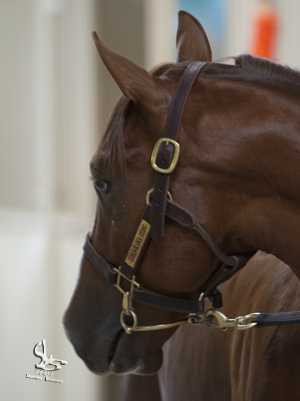
Anniversary Scooter, 2011 sorrel colt by Heza Motor Scooter out of Wild Wonder Child by Dash ta Fame, getting ready to go to the sale ring.
When you enter the sales pavilion at Heritage Place for the September Quarter Horse racing bred yearling sale you can easily forget that it is 90+° outside. After all, the pavilion, lobby, offices and restaurant are air conditioned for our comfort. But when you open the door to go into the barn to see the horses before they go into the sale ring the heat and the smell of horses hits you like a ton of bricks. A lot people would turn around and go back inside but for those of us with a love for horses it is either unnoticed or we relish it.
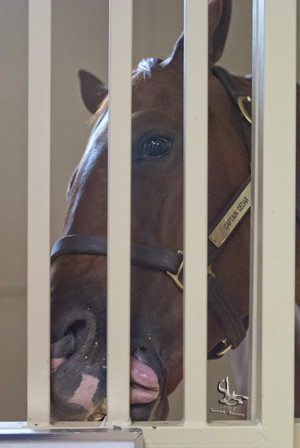
I’m bored says Captain Ceder, 2011 chestnut colt by Captain Courage out of Salt Ceder TB by Salt Lake, acting like a typical kid.
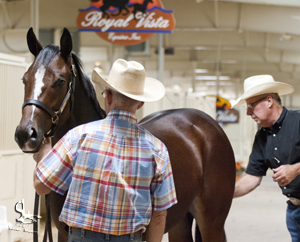
Ms First Prize Rose, 2011 bay filly by Coronas Cartel out of First Carolina by Mr Jess Perry, being prepped to go into the sale ring.
You are also struck by other sights and sounds. The most noticeable is the din of the auctioneer as he sells the horses. It is broadcast throughout the pavilion and the barns on loud speakers and TV monitors. Everyone standing around the make-up ring, where the horses wait before they go into the sales ring, is studying their sales catalog. A bible to the buyers that they’ve had their nose buried in since it arrived in the mail includes the pedigree and records of each prospect’s sire and dam.
Each consigner decorates their area differently. Some have a booth where they offer snacks, drinks and various information about their farm’s services, stallions and the yearlings that have at the sale. Some have video monitors with clips from races their stallions have won or videos about the services offered at their farm. Some aisles have plants. Some have fans. At least one had an air conditioner, a very popular place in the un-air conditioned barn today!
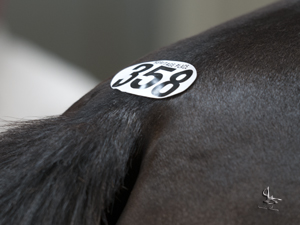
The hip number sticker at the base of Cha Ching Corona’s, 2011 brown filly by Coronas Leaving You out of This Lady Likes Cash by Feature Mr Jess, tale.
As you wander down the aisles you notice some of the yearlings are resting while others are playing with their buckets or the stall door. These are only babies after all. The poster on the front of the stall announces their number that indicates when they sell and where they are in the catalog. It also has their pedigree, their page out of the catalog and stickers for other engagements or tidbits of information. Plus if there are any updates to the information that is in the catalog there is another poster with that information. These are the fact and figures that entice prospective buyers to come take a look and, hopefully, at least two will decide “that’s the one that will win my dream races – I’ve got to have it!”
As each Quarter Horse racing prospect is taken out of its stall and prepared to go into the sales ring it is brushed to remove any dust and shavings paying particular attention to the mane and tail. They get a pedicure and an application of hoof oil to moisturize and make their hooves glisten. Baby oil is placed on their muzzle and other areas for a final polish. After all they have to look their best for this dance. Then a sticker with their sales number is placed at the base of their tale and they get their number painted on each hip. Now, after two long years since the mare was bred, they are ready to go to the make-up ring and await their turn in the sales ring.
As they enter the sales ring most of these babies are wide eyed but they have been prepared so they are well behaved. Sometimes the bidding starts slowly and sometimes there are a rush of bids. When the gavel falls on the final bid the young prospect is taken back to its stall to start a new chapter in its life that of a young race horse in training.
Best of luck to all the new owners and safe trips to all these young Quarter Race Horses!
Susan Bloom
Oakley, KS 67748-1350
785-671-4008
Web site contents and all Images
© CS Bar Quarter Horse Marketing,
Bloom Studio & Susan Bloom
Unauthorized use is prohibited.
Copyright © 2025 · News Child Theme on Genesis Framework · WordPress · Log in